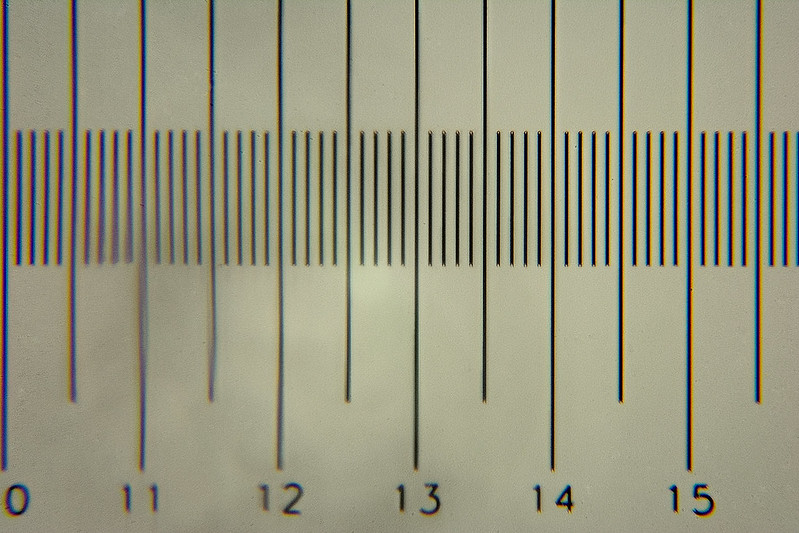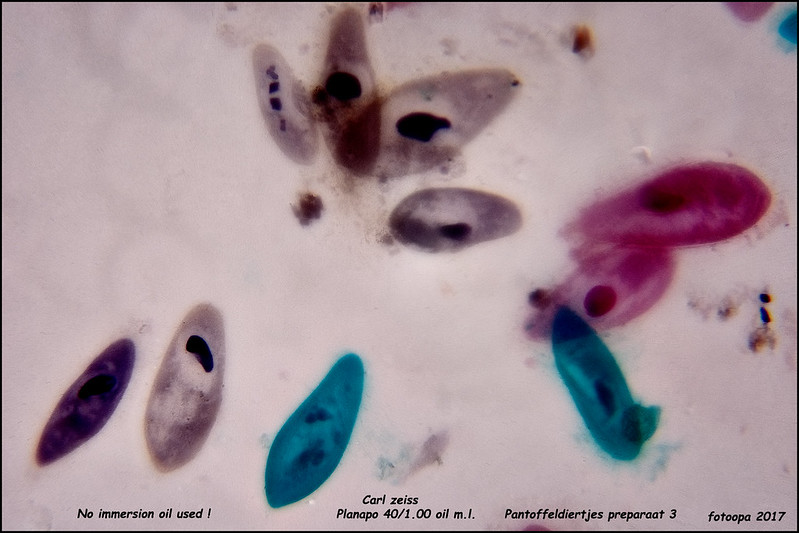It will still be a mystery, nowhere does you find a picture of the internal of this "Somatoscope III zoom". Still, it works as a whole, I put my 2mm / 200 div slide on it and with the zoom at least I had an image of 100 um (10 subdivisions) on the monitor screen. With the zoom at max the FOV was about 30 um. The image contrast and the sharpness was reasonable without oil between slide and lens (I have no oil now). Of course not as good as we now make stacking images. And provide lots of empty magnification.
I can just take away the upper part. I wonder how I could mount my D7100. I have a 100mm, 105mm and a 70-200mm lens available. Should there be a 160mm tube lens between the Carl Zeiss Plano 40 / 1.0 Oel and the Nikon camera lens? Mechanically I can do a lot considering I have the necessary tools. Electronic I can change a lot like changing the exposure to a powerled etc. The fine of the focus knob can I link to a stepper motor. Focus steps of 1 um should be possible for stacking.
I would only be able to make these changes at the beginning of next year. I have to finish my current running projects for my grandchildren first.
Frans.
Microscope Nikon SE with the "Somatoscope III-zoom"
Moderators: rjlittlefield, ChrisR, Chris S., Pau
I don't know what reasonable means. An oil lens used without oil produces a pretty fuzzy image both because the reduced NA and spherical aberration (some higher NA ones even don't produce an image at all). Oil immersion is easy to source. At this level you don't need top quality original oil, generic microscope immersion oil will do.fotoopa wrote:The image contrast and the sharpness was reasonable without oil between slide and lens (I have no oil now).
Nope, they are finite corrected objectives. You just need 150mm* of extension between the objective shoulder and the sensor, easy to do with bellows or tubes.Should there be a 160mm tube lens between the Carl Zeiss Plano 40 / 1.0 Oel and the Nikon camera lens?
That said the image at the center will be good but the periphery will show lots of lateral chromatic aberration because these objectives are designed to be paired with matched compensating eyepieces that correct the residual aberration not corrected at the objective. With APSC sensor you could get some corner vignette and/or degradation because they are designed to provide a quality image circle of 20mm
Even if all the image light path is optimized I doubt that the weird condenser could be able to provide enough light cone NA to profit the potential resolution of the objectives
* the extra 10mm of the 160 specification are the space between the primary image plane and the resting plane of the eyepiece at the end of the microscope tube
Pau
The monitor was just interlaced composite video 720x576. and without oil I could not expect much. With such image quality I would definitely not be satisfied.Pau wrote: I don't know what reasonable means. An oil lens used without oil produces a pretty fuzzy image both because the reduced NA and spherical aberration (some higher NA ones even don't produce an image at all). Oil immersion is easy to source. At this level you don't need top quality original oil, generic microscope immersion oil will do.
Fine, I now understand how it works. Bellows and tubes I have both. Mechanical adjustment would not be a problem.Nope, they are finite corrected objectives. You just need 150mm* of extension between the objective shoulder and the sensor, easy to do with bellows or tubes.
Here I could also use my olympus E-PL3 + nikon adapter. It has a smaller sensor that would fit better on a 20mm image circle. On the other hand, the ControlMyNikon software is better suited for connecting to the PC.That said the image at the center will be good but the periphery will show lots of lateral chromatic aberration because these objectives are designed to be paired with matched compensating eyepieces that correct the residual aberration not corrected at the objective. With APSC sensor you could get some corner vignette and/or degradation because they are designed to provide a quality image circle of 20mm
That can be a problem. Testing should provide clarity, or should I look to replace it.Even if all the image light path is optimized I doubt that the weird condenser could be able to provide enough light cone NA to profit the potential resolution of the objectives.
Yes I understand.* the extra 10mm of the 160 specification are the space between the primary image plane and the resting plane of the eyepiece at the end of the microscope tube
Thanks Pau for all this information. For me this is a valuable aid. I have to try to do something about it, the whole microscope seems too valuable to dump as planned original!
Frans.
Today, I've made an adapter to build the microscope for live vieuw recordings. I have no immersion oil, hence the sharpness is limited and there are additional color errors. Nevertheless, the results are promising. I'm using the Planapo 40 / 1.00 Carl Zeiss lens for the tests. Here are some pictures:

Conversion somato microscope P1017607 by Frans, on Flickr

ref slide 580 um dx format by Frans, on Flickr

preparaat3 PMax by Frans, on Flickr
Because the adapter is made with an F-mount, I can also connect my Olympus E-PL3 with adapter. It has a smaller sensor. I use the software ControlMyNikon live view shooting with the D7100. This works prefect and is very confortable for focus and shooting. I have to urgently order the immersion oil.
I hope the results with immersion oil will be a bit better.
Update:
FOV on the D7100 Nikon camera: 580 um.
FOV on the E-PL3 Olympus camera: 440 um.
Frans.

Conversion somato microscope P1017607 by Frans, on Flickr

ref slide 580 um dx format by Frans, on Flickr

preparaat3 PMax by Frans, on Flickr
Because the adapter is made with an F-mount, I can also connect my Olympus E-PL3 with adapter. It has a smaller sensor. I use the software ControlMyNikon live view shooting with the D7100. This works prefect and is very confortable for focus and shooting. I have to urgently order the immersion oil.
I hope the results with immersion oil will be a bit better.
Update:
FOV on the D7100 Nikon camera: 580 um.
FOV on the E-PL3 Olympus camera: 440 um.
Frans.
